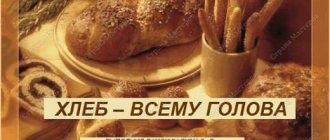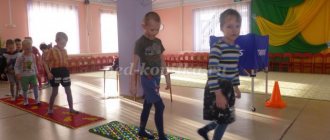SHORT-TERM PROJECT BREAD FOR EVERYONE'S HEAD
Transcript
1 In the middle group 3 SHORT-TERM PROJECT BREAD FOR EVERYONE’S HEAD Conducted by the teacher of MDOU 41 “Golden Cockerel” Zolotareva Lyudmila Nikolaevna Project implementation period: March 2022 Project duration: 2 weeks Type of project: short-term, practice-oriented project. Project participants: middle school children, teacher Focus of work: research.
2 Here is the fragrant bread, here it is warm and golden. He came to every house, to every table. It contains health, our strength, it contains wonderful warmth. How many hands raised him, protected him, took care of him. In it is the native juice of the earth, in it is the cheerful light of the sun. Grab it by both cheeks, grow up to be a hero! S. Pogorelovsky Relevance: Love and respect for bread must be taught from childhood, this love must be instilled in the family, in kindergarten and school. Bread in our country is a product of human labor, it is a symbol of life, health, and prosperity. It is bread that has the most important place on the table both on weekdays and on holidays. Not a single meal is complete without it. This product accompanies us from birth to old age. The value of bread cannot be measured by anything. But why do some children love bread and eat it with pleasure, while others refuse it? Many children do not know about the work of people who grow bread and treat bread carelessly (throwing it, crumbling it, making figures, throwing away half-eaten pieces). The project is designed to draw children's attention to the efforts that make bread appear on our table, and to cultivate a caring attitude towards bread. Goal: To expand children's knowledge about bread. Instill respect for bread and the people who grew it. Objectives: - expand children’s knowledge about the importance of bread in human life; — clarify children’s knowledge about the process of making bread as a useful and necessary product for human life; — learn to apply acquired knowledge in productive activities; - encourage active participation in joint activities of adults and
3 children; - develop creativity and imagination, thinking and curiosity, observation and imagination; - show how hard it is to earn bread for the people and each of us; — to cultivate a caring attitude towards bread, a sense of gratitude and respect for people who work in agriculture. Stages of project implementation 1. Preparatory stage: - drawing up a long-term action plan; — search for materials on this project; — development of notes on cognitive-speech and creative educational activities, observations, conversations; - selection of fiction, proverbs and sayings about bread; — selection of information material for the parents’ corner; 2. Main stage: 1. GCD: “From grain to bread”, “How bread grows”, “Where did bread come from?”, “Golden words bread is the head of everything.” 2. CONVERSATIONS: “How bread came to the table”, “What kind of bread is there”, “How to bake bread at home”, “Take care of bread”. 3. READING FICTION: Fairy tales: “Winged, hairy, and oily”, “Spikelet”; K. Chukovsky “Miracle Tree”, “Bun”; I. Tokmakova “What is bread”; N. Samkova “About Bread”; P. Koganov “Bread is our wealth.” Tongue twisters about bread - The baker baked a bagel, a bagel, a loaf of dough from the dough early in the morning.
4 - The pie is good inside the curd. - Sasha likes sushi, Sonya likes cheesecakes. — Vanya was lying on the stove, eating rolls. Proverbs and sayings about bread - If there is bread, there will be lunch. “The sweat is on your back, and so is the bread on the table.” - Without salt it’s tasteless, and without bread it’s unsatisfying. - If you don’t fertilize the rye, you’ll collect bread for a penny. - As long as there is bread and water, it’s not a problem. “You won’t be satisfied with conversation if you don’t get bread.” “You won’t be full without bread and honey.” “It’s bad to live without bread and near water.” Signs about bread - It was not allowed for one person to finish the bread after another; you would take away his happiness and strength. “You can’t eat behind another person’s back; you’ll also eat his strength.” - If you give bread from the table to the dogs during meals, poverty will befall them. “People who break bread become friends for life.” — When taking bread and salt on a towel, you should kiss the bread. Games Didactic games: “What was baked from what flour”; “What first, what then”; “What kind of bread is it?” “Who can name the most bakery products” Role-playing games: “Bread”, “Where did the bread come from?”, “Dough” Outdoor games: “Loaf”, “Plant a grain”
5 Artistic and creative activity - Drawing grain fields
6 – Modeling bakery products
7 Experimental activities growing seeds of oats, rye, wheat
8
9
10
11 — Parents baked pancakes for children
12
13 - Played the outdoor game “Loaf” - Played the outdoor game “Planted a Seed”
14 Role-playing games - “Treating bakery products”
15 Interaction with parents - Invite parents to find and learn poems, proverbs and sayings about bread together with their children. — Invite parents and their children to make baked goods at home.
16
17 Conclusion In the course of project activities on a given topic, children learned about Russian traditions associated with growing bread in Rus', about the processes of processing grain and baking various bakery products, about the value of bread for humans. They now know how much work goes into every piece of bread. The children stopped playing with bread. Parents took an active part in the implementation of the project.
Project for older preschoolers “Bread is the head of everything”
MBDOU "DS combined type No. 19"
Ecological,
educational - research practice-oriented project
“Bread is the head of everything!”
for children of senior preschool age
Authors:
Boriskina V.S., Kolosova G.N., Chuchvareva T.V.
Description:
This material will be useful to teachers and parents in order to increase the knowledge of children and adults about the importance of bread in human life;
introducing children and adults to careful use of bread, as well as organizing events with children of senior preschool age. Relevance of the project:
There are concepts in the world that never lose their value for people, they are unshakable, we will talk about bread. I often ask my son, come in and buy some bread; As a child, I told my children, eat with bread! A person needs bread every day. Neither breakfasts, nor lunches, nor holiday feasts are complete without it. Bread is a symbol of well-being and prosperity! In the old days, bread was always treated in a special way, compared to the sun, gold, and life itself. At all times, a careless attitude towards bread has been equated with a terrible insult that could only be inflicted on a person. My mother was born in a village, and her childhood was during the war years. She told us that her greatest desire was to eat a large piece of black bread! From childhood we were taught to treat bread with care as our greatest wealth. So where does bread come from? Maybe buns grow on trees? With the help of an environmental project we will find out!
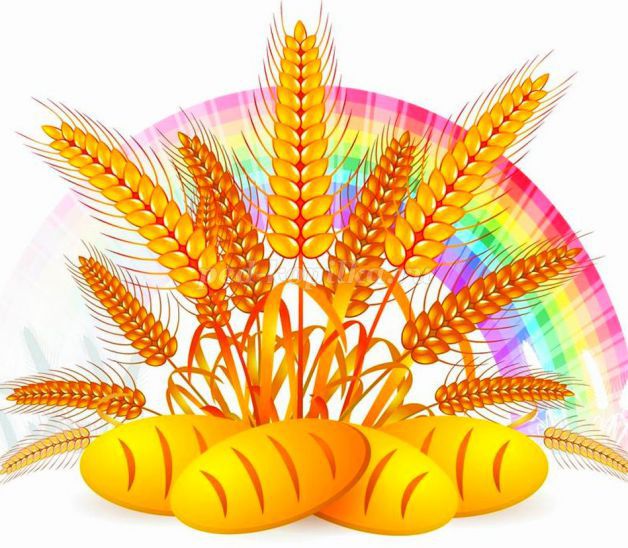
Purpose of the project:
The project is designed to draw children's attention to the efforts of adults to bring bread to our table; The project is designed to foster a caring attitude towards bread and the work of the grain grower.
Target:
the formation of a holistic understanding of the process of growing bread in children of senior preschool age, instilling a caring attitude towards bread and the work of the people who grow it.
Objectives:
Educational:
• study the history of bread;
• introduce children to ancient Russian customs related to bread; • expand children's knowledge about the importance of bread in human life and its production. Developmental:
• develop cognitive and research activities;
• develop the ability to think logically, reason, draw conclusions and conclusions. Educational:
• to cultivate a caring attitude towards bread, a sense of gratitude and respect for people who work in agricultural fields;
• cultivate a desire to share acquired knowledge. Project participants:
senior preschoolers, teachers, speech therapist, parents.
Project type:
ecological, educational and research.
Project duration:
short
Resource support:
multimedia equipment, music center, audio and video library; books with fairy tales, panoramic books, coloring books; didactic games; puzzles on the topic; art albums and illustrations on the topic.
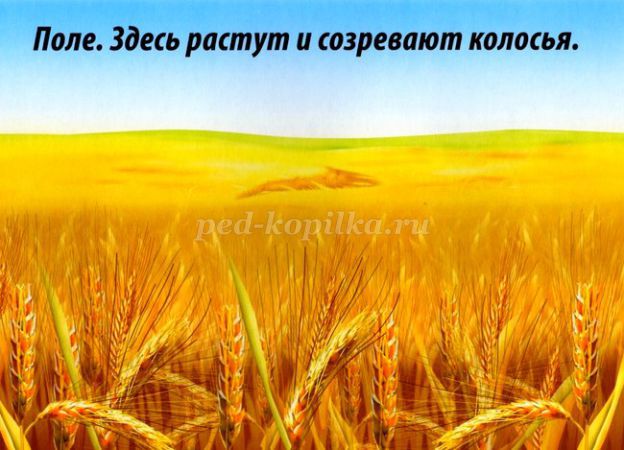
Preliminary work:
• Collection of information: about cereal plants, about agricultural machinery, about grain growers, about folk traditions.
• Selection of demonstration material: pictures, illustrations, video material, cereal plants, cereals, flour from various cereals, household items. • Selection of artistic and literary material: proverbs, sayings, sayings, stories, fairy tales, parables, poems. Folk calendar: main agricultural dates - according to the old style (April, May, June).
• Stepan the Ravnopashets (April 26) - the beginning of plowing the fields for sowing spring grain. • Eremey-harness (May 1) - peasants begin plowing and sowing fields with spring grain. • Orina-seedling (May 5) - cabbage sowing time. • Nikola grass (spring, spring) (May 9) - as a rule, by this time the first grass appears - spring is in full swing. • Lukerya-komarnitsa (May 13) - by mid-May, mosquitoes appear in central Russia. • Northern Sidor (May 14) - usually at this time northern winds begin to blow, and it gets colder in Russia for about two weeks. • Reindeer flax seeding (May 21)—time of the start of flax sowing. • Fedosia-ear (May 29) - the ear goes into winter bread. • Jeremiah the Unharness (May 31) - the end of sowing spring grain. Peasants unharness oxen and horses from a working yoke. • Sharktail (June 13) - during this period, midges, mosquitoes, gadflies, spiders and other insects appear in central Russia, disturbing people and livestock. Animals often run across the field and lash themselves with their tails, swatting away pests. • Agrafena-swimsuit (June 23) - the beginning of the swimming season in Rus', the water is warming up by this time.

Expected Result:
• developing in children an idea of the value of bread; • children gain knowledge about how bread was grown in the old days, and how it happens now, to convey to children that bread is the result of a lot of work by many people; • fostering interest in the professions of baker, confectioner, combine operator and in the work of people involved in bread production; • fostering a caring attitude towards bread and bakery products. Research methods:
• collection of information;
• conversations; • observations; • experimental – experimental activities; • analysis. Interaction with parents:
• Invite children to learn poems, signs, proverbs and sayings about bread together with their parents. • Together with families, compile a cookbook “Ancient Recipes of Our Grandmothers.” • Joint quiz with parents: “Smart guys and smart girls.” • Tea party with families (with homemade cakes). • Release of the wall newspaper “Bread is our wealth!”
Integrated educational areas:
• Cognitive development; • Speech development; • Social and communicative development; • Artistic and aesthetic development. Cognitive development:
Conversations: “How bread came to our table”; “Who is the grain grower”, “Bread is the head of everything!” “What kind of bread is there?” “How to bake bread at home”; “Bread is our wealth!”
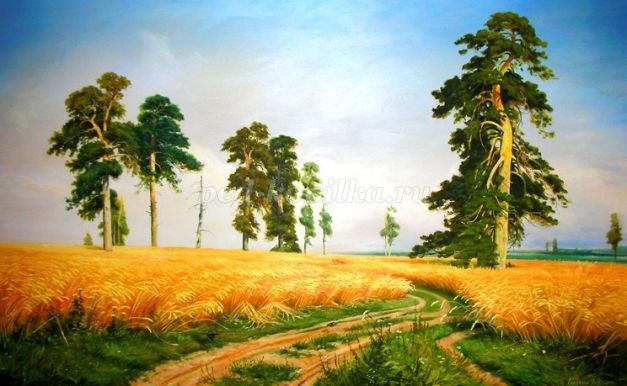
Examination of illustrations and reproductions: Examination of a series of plot pictures on the topic: “Growing bread”; Compiling stories based on the illustration “How bread is grown”; Examination of paintings by I. I. Shishkin “Rye”, I. I. Mashkov “Moscow Snack”, S.A. Kupriyanova “Plowing”, “Sowing”, “Harvesting”, “Winter Crops”. Watching documentaries: “The Story of Bread”; “A secret to the whole world. How bread is made"; “How bread is baked!” Program for children “ABVGDeyka”. Watching cartoons: “Golden Ears” Belarusian fairy tale; "The story of the girl who stepped on bread." Based on the fairy tale by Hans Christian Andersen; "Kolobok" Russian folk tale; “Bread” Belarusian fairy tale; “Miracle - the mill!” Russian folk tale. Introduction to professions: • Agronomist; • Combiner; • Baker; • Confectioner; • Salesman.
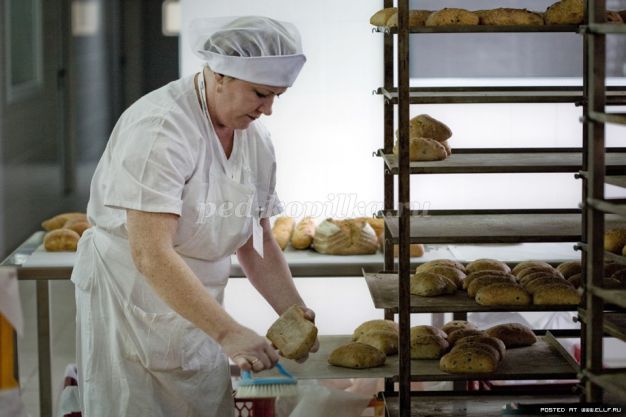
Research activity: Examining and comparing grains with a magnifying glass (rye, wheat, barley, oats). Building a diagram of “Stages of growing bread”; Experimental activities: Converting grain into flour (mortar, coffee grinder). Growing seeds (rye, wheat, barley, oats). Kneading dough and baking bread in an electric bread maker (with the help of parents). Speech development:
Reading fiction about bread: • Fairy tales: “Light bread”, “Krupenichka”, “Winged, furry, and buttery”, “Spikelet”; “Kolobok” (See Appendix 3) • V. Datskevich “From grain to loaf”; • K. Chukovsky “Miracle - Tree”, “Bulka”; • V. Remizov “Bread Voice”; • Y. Akim “Bread”; • T. Shorygina “A Loaf of Bread”; • D. Kharms “Very, very tasty pie”; • I. Tokmakova “What is bread”; • N. Samkova “About bread”; • P. Koganov “Bread is our wealth”; • Riddles, tongue twisters, proverbs, sayings, poems, signs about bread (See Appendix 1, 2)
Social and communicative development:
Role-playing games: “Family”; "Shop"; "Bakery"; "Cooking." Didactic games: • “Name the profession”; • “What grows where”; • “What flour was baked from?”; • “The fourth wheel”; • “From grain to loaf”; • “What’s first, what’s next”; • "Transformations"; • “Wonderful bag”; • “What kind of bread is it?”; • “Who can name more bakery products”; • “Guess the taste”; • “Guess by touch”; • “What did you cook the porridge from?”; • “How to turn flour into dough?”; • “Call me kindly.”
Artistic and aesthetic development:
Visual activities:
• looking at pictures and illustrations about bread; • modeling bakery products from salt dough with children for the role-playing game “Bakery”; • making pictures from semolina; • image of grain fields; people who grow bread. GCD:
“Where does bread come to us from”; “Bread is the head of everything”; Compiling stories based on the series of paintings “How People Grow Bread”; Conversation: “What would you like to become?” (professions of grain grower, baker...).
Story from pictures:
How did people grow bread in the old days?!
Interaction with parents
• Invite children, together with their parents, to find and learn poems, proverbs and sayings about bread. • Production of a group cookbook “Recipes of our grandmothers.” • Tea party with parents (with baked goods). • Theatricalization of the Russian folk tale “Spikelet”.
Project stages:
1. Preparatory stage:
• identification of objects of study;
• selection of cereal seeds, care items, dough molds, hand mill; • selection of proverbs and sayings, riddles about bread. 2. Main stage:
• obtaining flour from grain; • study of the properties of flour and dough.
• baking flour cakes with children
• tasting of flour products brought from home, baked by parents
3. Final stage:
• generalization of the results of the work;
• setting up an exhibition of dough crafts; • dramatization of the Russian folk tale “Spikelet”; • holding the final event “Bread is the head of everything!” In our work we relied on the following principles:
• a unified approach of teachers and parents to the process of raising children;
• mutual trust in the relationship between teachers and parents; • differentiated approach to each family; • respect and goodwill towards each other; • openness of the preschool institution for parents; • equality and responsibility of parents and preschool teachers. Innovative forms and methods of working with families:
Parents' living room on the topic: “How to bake bread at home?”;
Thematic exhibition of drawings and crafts “Bread is the head of everything”; Competition for the best craft: a screen, a wall newspaper, a small book “About Bread”. Forms of work:
• Didactic games.
• Music classes. • Teacher's stories about bread and cultivators. • Organization of themed leisure and entertainment. • Conversations-dialogues. • Reading children's literature on the topic. • Show views on a topic. Expected result:
The implementation of the project contributes to: - the formation of environmental ideas among preschoolers about the value of bread;
- for children to gain knowledge about how bread was grown in the old days, and how it happens now, to convey to children that bread is the result of a lot of work by many people; — fostering interest in the professions of baker, combine operator and the work of people involved in bread production; - formation of a caring attitude towards bread in children and adults. List of used literature:
1. Shorygina, T.A.
Conversations about bread. Guidelines. M.: TC Sfera, 2016. – 80 p. 2. Kochkina, N.A. Project method in preschool education. Methodological manual – M.: – Mosaic – Synthesis, 2013. – 70 p. 3. Emelyanova, E.L. — Tell the children about bread. Cards for activities in kindergarten and at home. 3-7 years old, Mosaic-Synthesis, 2011, Dimensions: 216x145x5 mm Internet resources
Appendix 1
Riddles, tongue twisters, tongue twisters, proverbs, sayings, signs about bread.
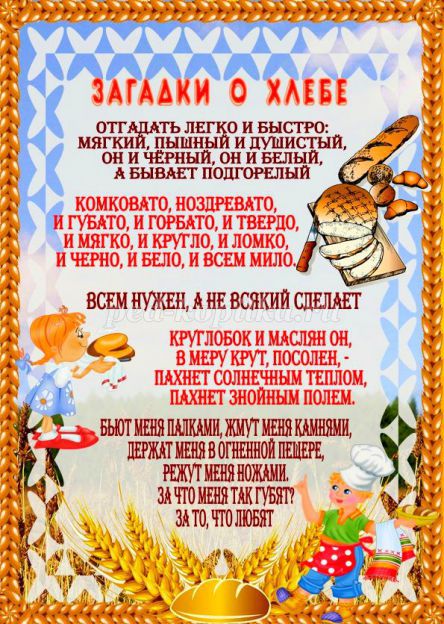
Riddles about bread:
1. Was a grain of gold, became a green arrow. The summer sun was shining and the arrow was gilded. What kind of arrow? (ear). 2. Which sea behind the village is excited by the breeze? In it, waves can be collected and placed in a bag (field). 3. A hundred brothers gathered in one hut to spend the night (grains in an ear). 4. I’ll tell you a riddle: I’ll throw it behind the garden bed, let it go one year, and release it the next (winter). 5. Crumbs into the ground, cakes (wheat) out of the ground. 6. They are crushed and rolled, hardened in the oven, and then cut with a knife (bread) at the table. 7. A plate of soup between the elbows, and everyone has it in chunks in their hands. Without it, apparently, it is neither tasty nor satisfying (bread). 8. There are these words: “He is the head of everything.” 9. Dressed with a crispy crust, soft black, white (bread). 10. We baked rye bricks in a hot oven, loaded them onto the car - buy them in the store (bread). 11. At one large factory, it doesn’t even look like brick, bricks are baked in a fire-breathing oven. I bought a brick at lunch, because I need (bread) for lunch. 12. Don’t peck me, my friend, loud cockerel! I will go into the warm earth, and rise up to the sun like a spikelet. Then there will be a whole family (seed) of people like me. 13. He threw one and took a whole handful (grain). 14. If he borrows grain, he will return the loaf (grain field). 15. He stands in the sun and moves his mustache. If you crush it in your palm, it will be filled with golden grain. 16. A peasant lies in a golden caftan, girded, not with a belt, If you don’t lift him up, he won’t get up (sheaf). 17. Mowed with a sharp scythe, piled (hay) into a high mountain. 18. An unusual hairdresser cuts his wheaten forelock smoothly, and behind him lie scattered shocks of golden hair (combine). 19. A house grew up in a field, the house was full of grain. The walls are gilded, the shutters are boarded up. The house is shaking on a golden pillar (spike). 20. The teeth move, the combs wave, the reapers run across the field, Like a boy running under a typewriter, the field is cut bare (harvest). 21. They have teeth, but they don’t know toothache (rakes). 22. In winter - white, in spring - black, in summer - green, in autumn - cropped (field).
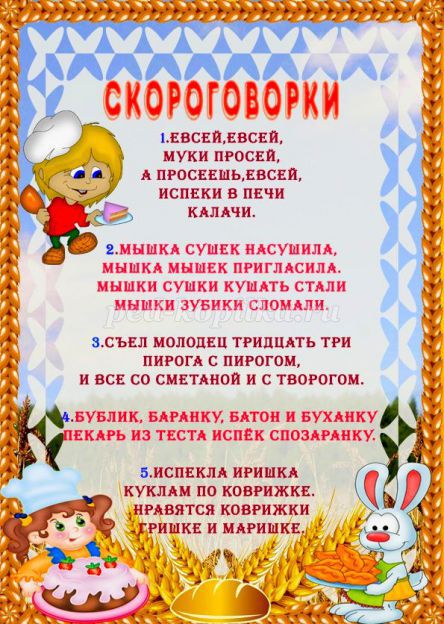
Tongue twisters and tongue twisters about bread:
A good pie - there is curd inside. Sasha loves sushi, Sonyushka loves cheesecakes. Vanya was lying on the stove, eating rolls. Zhenya is a reaper in the field, she reaps wheat. The baker baked the bagel, bagel, loaf and loaf from the dough early in the morning. Sasha walked along the highway and sucked on a dryer. Zhok-zhok-zhok is a pie. Shki-shki-shki - mom is frying pies. Shki-shki-shki - we love pies. Zhok-zhok-zhok - eat Zhenya’s pie. Ach-ach-ach - here is a kalach. Chi-chi-chi - rolls are baked in the oven. Chi-chi-chi - we love rolls. Chi-chi-chi - there will be rolls for the holiday.
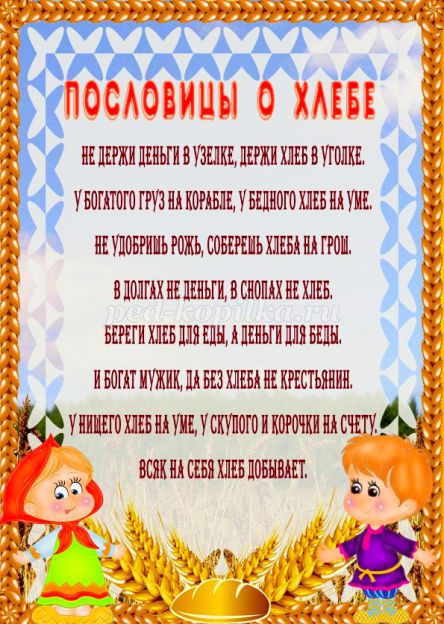
Proverbs and sayings about bread:
In winter the snow is deep, in summer the bread is high. Bread is the head of everything. There will be bread, there will be lunch. Sweat on your back and bread on the table. Without salt it is tasteless, and without bread it is insatiable. Bread is a gift from God, a father, a breadwinner. Black soil produces white bread. And lunch is not lunch if there is not enough bread. I'm glad to see the tablecloth, he's like the sun on it. If you don't fertilize the rye, you'll collect a penny's worth of bread. As long as there is bread and water, everything is not a problem for a person. You won’t be satisfied with conversation if you don’t get bread. Without bread and honey you will not be full. All bread eats, but not everyone sows it. Without salt the table is crooked. If only I had flour and a sieve, I would be full. Water will wash you, bread will feed you. The hungry godfather is all about bread. Bitter work, but sweet bread. Just as there is a land of bread, so there is paradise under the fir tree, but there is not a piece of bread, so there is melancholy everywhere. His mouth opened like a piece of bread. The roll will become boring, but the bread never will. It's hard to earn bread, but you can live with bread. Rye bread - grandpa rolls it. Fish is not bread, you won't be full. Your own bread is more filling. Eat your bread at least at night. No matter how much you think, you can’t think of better bread and salt. A well-fed man counts the stars in the sky, but a hungry man thinks about bread. He who has bread has happiness. Smart kid: he knows that bread is not chaff. Bread is father, water is mother. Bread on the road is not a burden. The bread in a man is a warrior. Bread will nourish you, water will give you drink. Bread and water are great food. Bread and water are our noble food. Bread is expensive, but not more expensive than you and me. Eat the pies, and save the bread ahead!
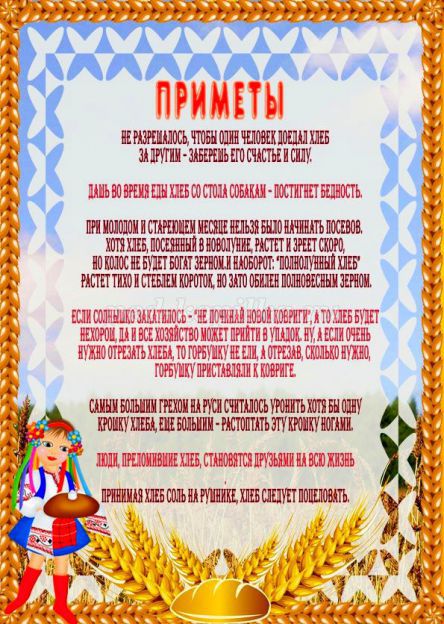
Signs about bread:
It was considered the greatest sin in Rus' to drop at least one crumb of bread, and an even greater sin was to trample this crumb underfoot. People who break bread become friends for life. When taking bread and salt on a towel, you should kiss the bread. With a young and aging month, it was impossible to start sowing: “It is good to sow when the month is full!” Although bread sown on the new moon grows and ripens quickly, the ear will not be rich in grain. If the sun has set, “don’t start a new war,” otherwise the bread will not be good, and the entire economy may fall into disrepair. It was not allowed for one person to finish eating bread after another - you would take away his happiness and strength. You can’t eat behind another person’s back—you’ll also eat his power. If you give bread from the table to dogs during a meal, poverty will befall you.
Appendix 2
Poems about bread
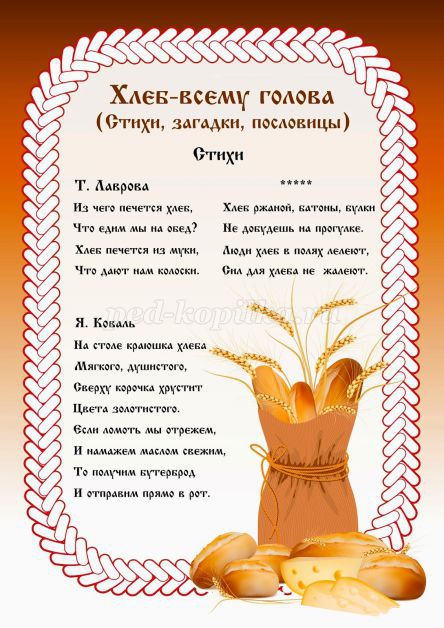
T. Lavrova
What is bread made from, what do we eat for lunch?
Bread is baked from the flour that the ears of corn give us. Rye and wheat feed people generously throughout the centuries. Buns with poppy seeds, sour cream cake, Black with cumin, peklevanny, Rolls, loaves, challah... Bread for young and old, For Tanya and Natasha. Good bread is our breadwinner! How delicious the bread is, I washed the bread down with water - lunch, And for dinner, two small crusts With a full mug of milk, What's left, put everything in the palm of your hand, Throw it onto the path for the birds. A. Malakhova
There are such words: “He is the head of everything.” Dressed with a crispy crust, Very soft white BREAD.
Y. Koval
There is a crust of bread on the table, soft, fragrant, the crust on top is crunchy, golden in color. If we cut a slice and spread it with fresh butter, we will get a sandwich and send it straight to our mouth.
A. Grishin
They will tell you and you will read in books: Our daily bread has always been held in high esteem.
A low bow to the masters of the harvest, to those who multiply the grain in the bins, and to the skillful bakers, to everyone who pleases us with delicious bread. S. Melnikov
The golden wheat of the millstone will be ground into flour.
Let's knead the dough from the flour - It has a place in the molds in the oven. It's browned and strengthened. There's delicious bread in the hot oven. G. Stetsenko
They put black bread for my lunch with white bread.
Did you decide to surprise me? Black? What is his secret? Apparently the baker was reluctant to bake and forgot the bread in the oven? Or didn’t you wash your hands clean before work? Mom immediately explained that there is rye flour: “Black bread will add strength.” Ate it. And tomorrow I will eat! I. Konkov
The most delicious, incomparable, familiar to everyone since childhood - This is our ordinary and favorite Russian bread: A fragrant, noble loaf, Pretzels and rolls, A fragrant bagel with poppy seeds, And Easter cakes.
You can eat it with honey and butter, with cheese, fish, ham, and with caviar, a circle of sausage, white or rye bread. Pies are special bread, they are served on holidays, and everything is prepared with baking and baked with filling. Donuts, donuts, cheesecakes They want to jump off the baking sheet - These are bread toys, A joy for the children on holiday. Or gingerbread cookies, what mom bakes, a delicious treat for the kids, Open your mouth wide! N. Children's
I didn't eat bread today, I looked at it through a magnifying glass.
It's all covered in patterned holes... In the holes it's white, in the holes it's black. I'll look at the lamb, There are dimples in the bun too. I asked my grandmother: “Was the pie full of holes?” The grandmother laughed: “And pancakes!” What is this secret? We need to look into the dough. Mom kneaded the dough, the dough was gaining strength! It rose like a round cap, grew and spread. The edge of the bowl fell out... Who pushed it up? - Mom, look through the magnifying glass! Bubbles are coming out! What are the bubbles hiding? Air! They have it inside. That's where there are holes in bread, That's where there are holes in bread! Because there, inside, are Bubbles-heroes! Appendix 3
Russian folk tale “Spikelet”
Once upon a time there were two mice, Twirl and Twirl, and a cockerel, Vociferous Neck. All the little mice knew was that they sang and danced, twirled and twirled. And the cockerel rose as soon as it was light, first woke everyone up with a song, and then got to work. One day the cockerel was sweeping the yard and saw a spike of wheat on the ground. “Cool, Vert,” called the cockerel, “look what I found!” The little mice came running and said: “We need to thresh it.” -Who will thresh? - asked the cockerel. - Not me! - the cockerel with a broom screamed alone. - Not me! - shouted another. “Okay,” said the cockerel, “I’ll thresh it.” And he got to work. And the little mice began to play rounders. The cockerel finished threshing and shouted: “Hey, Cool, hey, Turn, look how much grain I threshed!” The little mice came running and squealed in one voice: “Now we need to take the grain to the mill and grind the flour.” - Who will bear it? - asked the cockerel. - Not me! - Krut shouted. - Not me! - Vert shouted. “Okay,” said the cockerel, “I’ll take the grain to the mill.” He put the bag on his shoulders and went. Meanwhile, the little mice started leapfrog. They jump over each other and have fun. The cockerel has returned from the mill and is again calling the little mice: “Here, Spin, here, Spin!” I brought flour. The little mice came running, looked, and couldn’t boast enough: “Oh, the cockerel!” Well done! Now you need to knead the dough and bake the pies. - Who will knead? - asked the cockerel. And the little mice said again: “Not me!” - Krut squeaked. - Not me! - Vert squeaked. The cockerel thought and thought and said: “Apparently, I’ll have to.” He kneaded the dough, hauled in the wood, and lit the stove. And when the oven was heated, I planted pies in it. The little mice don’t waste time either: they sing songs and dance. The pies were baked, the cockerel took them out and laid them out on the table, and the little mice were right there. And there was no need to call them. - Oh, I'm hungry! - Krut squeaks. - Oh, I’m hungry! - Vert squeaks. Hurry up and sit down at the table. And the cockerel says to them: “Wait, wait!” First tell me: who found the spikelet? - You found! — the little mice squealed loudly. - Who threshed the spikelet? - the cockerel asked again. - You threshed! - they both said more quietly. -Who carried the grain to the mill? “You too,” Krut and Vert answered very quietly. - Who kneaded the dough? Did you carry firewood? Did you heat the stove? Who baked the pies? “All of you, all of you,” the little mice squeaked barely audibly. - What did you do? What should I say in response? And there's nothing to say. Twirl and Twirl began to crawl out from behind the table, but the cockerel could not hold them back. There is no reason to treat such lazy people and lazy people with pies! END
Appendix 4
Ancient recipes for baking bread and bakery products
